Menu
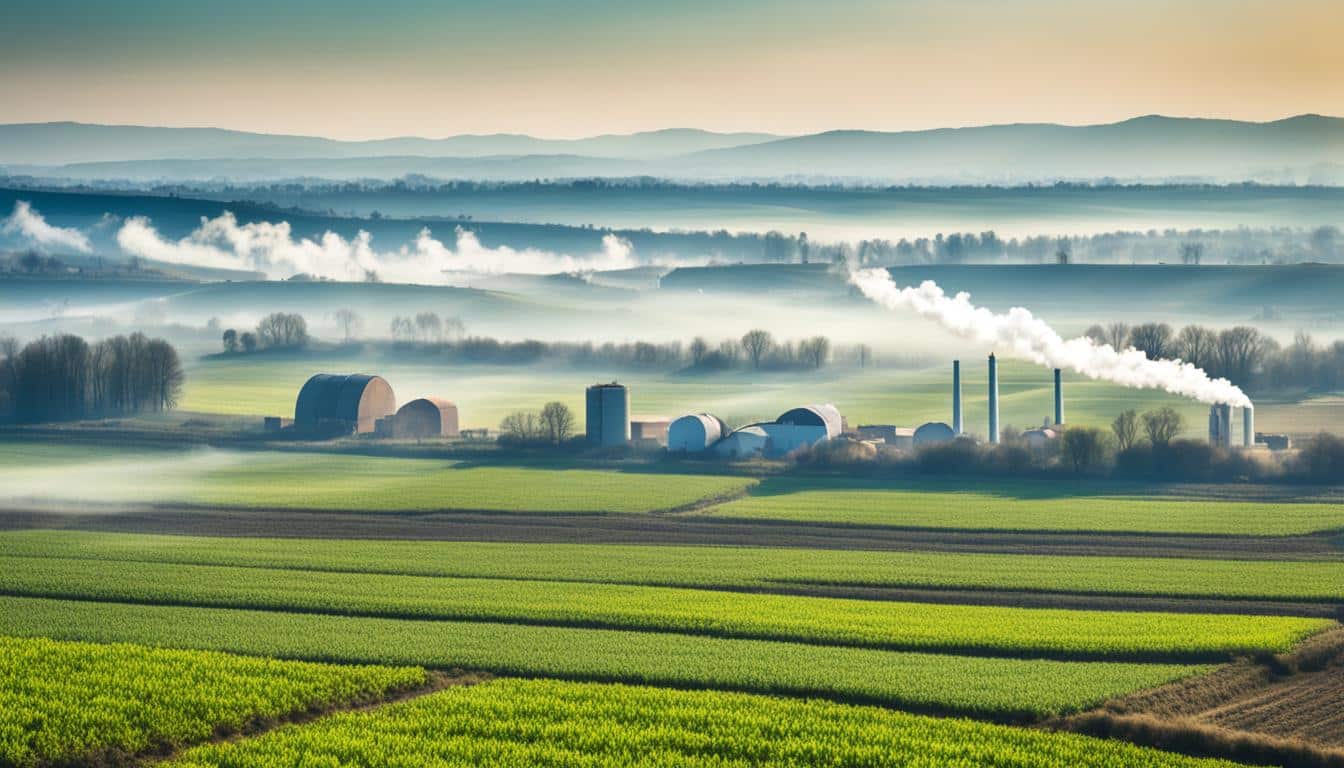
Did you know that in the United States, agriculture is responsible for almost all ammonia emissions? This highlights the major part farms play in making the air dirty. Farms also release a big share of small particles (PM 2.5) and larger particles (PM 10). This has a big effect on the air we breathe.
Understanding how global air quality standards affect farming is really important. Bad air filled with pollution affects the amount of crops we can grow. It can also harm the crops themselves. This, in turn, affects the food we have access to around the world.
Farming both creates and suffers from the pollution. This is a key point. It also shows us that making the air cleaner is crucial for the future of farming. We need to use methods that don’t harm the air and cut down on the bad stuff we put out there. This would help us have cleaner air and better farming in the years to come.
Air pollution affects farming in many ways, like reducing crop growth and making food supplies less secure. Farming also plays a big part in creating air pollution. This shows how farming and air quality are strongly connected. It’s key to grasp this link to cut down on emissions in farming.
Agriculture significantly impacts the air by releasing emissions from livestock and using chemicals. This contributes to pollution, which can affect both cities and the countryside. For example, farms produce a lot of nitrous oxide and methane. These are major pollutants. But, farming can also suffer from bad air. For example, high ground-level ozone can lower crop yields.
Pollutants like black carbon have fast, harmful effects on health and the environment. The World Health Organization says outdoor air pollution causes around 4.2 million deaths each year. These pollutants also hurt farming by slowing down photosynthesis and lowering crop output. Plus, farming itself adds to the air pollution. Farms in Europe, for instance, create a significant amount of the pollution found in its cities.
Climate change and farming influence each other a lot. The UN warns that major crops might drop in yield as the world gets hotter. Farming is a big part of creating greenhouse gases. So, it’s crucial that farming lessens its impact on climate change.By using more sustainable methods, farming can cut its negative influence on the environment. This will help keep food production steady and protect our planet.
Air pollution is a big problem for farming. Ground-level ozone is a key issue. It comes from things like cars and factories. This ozone harms crops a lot. It can cause big problems for farmers.
Ozone at ground level is bad for many key crops. It messes up photosynthesis. This makes the leaves look sick and stops the plants from growing well. In the end, we get less food from them.
By cutting down on things that make ozone, we can help crops. For example, we need to reduce nitrogen oxides. Doing this can make crops grow better.
In places with a lot of air pollution, crop effects are bad. Yet, if we cut pollution, we can grow more food. For example, in Western Europe, less nitrogen oxides could mean a 10% increase in crops.
In India, cutting pollution could give us 8% more summer crops and 6% more winter crops. This shows how important it is to fight air pollution. We need to protect our main foods.
Less food from crops means problems. Ozone and other pollution can cut yields by 5% to 12%. This leads to big money losses for farmers, worth billions.
If we lower pollution, we can save money and grow more food, like corn and soy. A study from 1999 to 2019 showed that by reducing certain pollutants, crops did 20% better. This saved about $5 billion each year.
So, it’s clear, we must improve the air. Doing this can help farmers a lot. Using new, clean methods and tech is key. It makes farming stronger and healthier.
Understanding international agricultural air quality standards is key. The WHO’s new Global Air Quality Guidelines aim to reduce harmful pollutants. They focus on six pollutants, including PM, O₃, NO₂, SO₂, and CO. Following these rules, the farming sector can lessen its impact on air quality. This, in turn, helps protect crops and animals from the negative effects of air pollution.
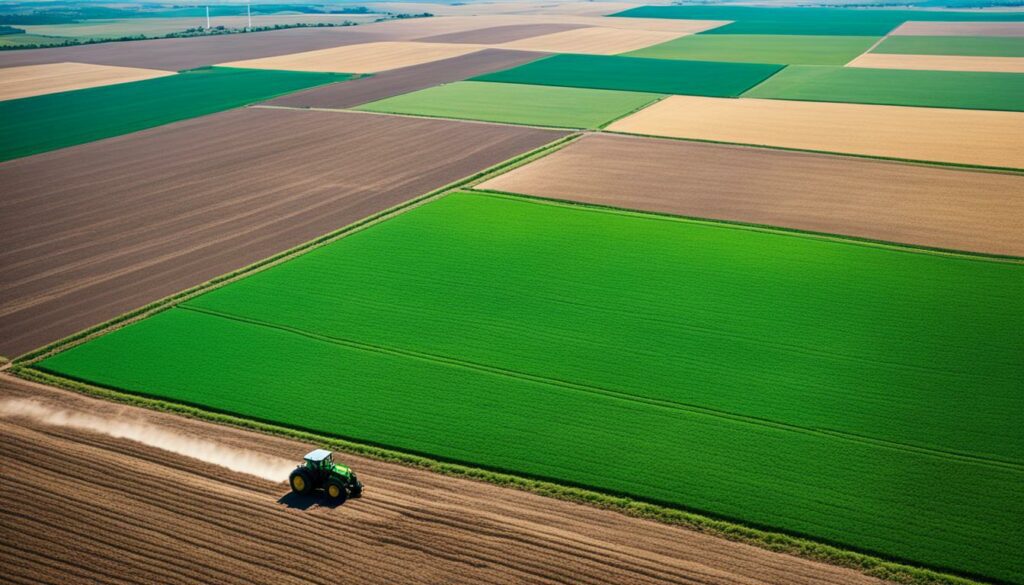
Currently, air pollution leads to around 7 million early deaths every year. It greatly affects both public health and farming. Harmful pollutants like PM₁₀ and PM₂.₅ can cause illnesses. These include respiratory issues, asthma, and heart problems. The goal of global air quality standards for agriculture is to lower these health risks through strict rules.
The problem of air pollution affects people unevenly around the world. A large part of the population faces air quality worse than the set standard. The most polluted areas include parts of Asia and the Mediterranean. By adopting the same guidelines globally, we can work towards a cleaner environment everywhere.
Agriculture plays a big role in air pollution, producing a quarter of the world’s greenhouse gases. Livestock, manure, and farm chemicals cause most of the ammonia emissions. This leads to harmful pollutants in the air. To protect our planet, it’s vital for agriculture to meet strict air quality rules. Doing so helps us all breathe cleaner air.
Farming significantly affects the quality of our air, leading to harmful emissions. It’s key to know how farming adds to air pollution. This helps in solving the problems it causes for our planet.
Livestock has a big environmental impact. Their manure is a major source of air pollution. The industry contributes 18% of greenhouse gases, around the world.
This includes 65% of the world’s nitrous oxide, and 37% of its methane. These gases come mainly from livestock farming. Livestock’s manure also creates 95% of ammonia emissions. This is a big cause of the dirty air in cities across Europe.
Using fertilisers and pesticides also harms the air. These chemicals can travel far and affect air in cities. Agriculture is the top source of nitrous oxide emissions, at 72% globally. The main reason is the heavy use of fertilisers.
Agricultural activities release dangerous particulate matter. In the U.S., farming causes most of the ammonia and 16% of PM 2.5 and 18% of PM 10 emissions. These particles can cause breathing problems by getting deep into our lungs.
In Asian countries, burning stubble after harvesting is a big issue. It releases a lot of particles into the air, breaking global burning rules.
| Contributor | Percentage of Emissions |
|---|---|
| Livestock Manure (Ammonia) | 95% |
| Nitrous Oxide (Fertiliser) | 72% |
| Overall Greenhouse Gases | 25% |
| PM 2.5 from Agriculture | 16% |
| PM 10 from Agriculture | 18% |
Air pollution rules are big in farming. They change how we farm for the better. The main goal is to cut down on harmful gases and particles like ammonia and methane.
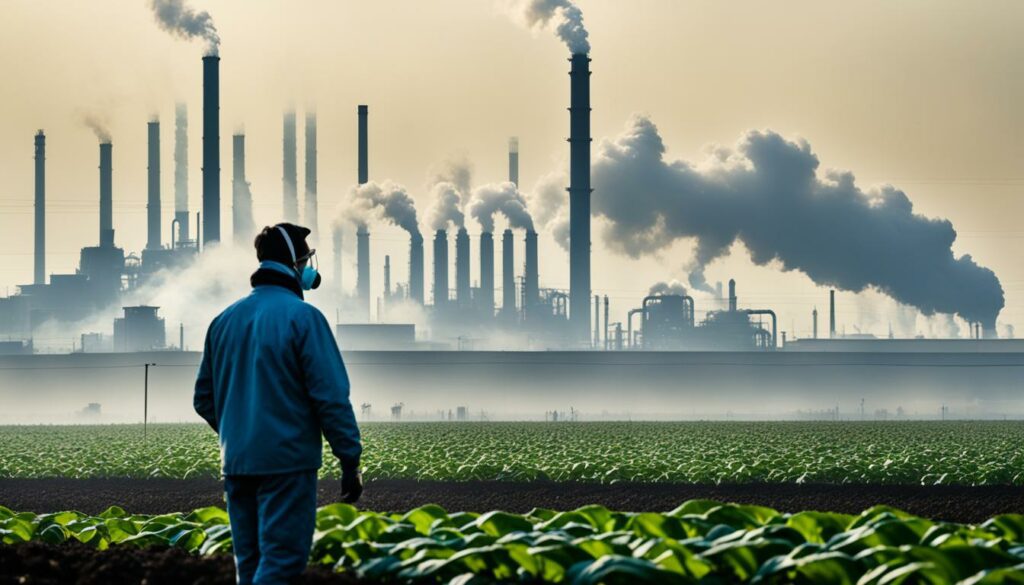
Farming is a huge source of ammonia in the world, making up 64% of it. In the European Union, farming causes 93% of the ammonia out there. That’s a lot. So, having strict rules for farms is really important.
The EU tracks the rules’ impact well. They use information like how much ammonia drops over time. This is key for checking if the rules work.
Another big issue is methane from farming, making up 29% of all emissions. Methane leads to ground ozone. This bad ozone hurts air quality and crops. In Italy, they’re looking at ways to cut down on these gases from farms.
But, the EU also lets countries make their own rules to solve local issues. Farming’s impact on the air can vary a lot by area. So, these local plans help solve problems better.
In the United States, agriculture faces similar challenges. It’s a big part of the country’s ammonia issue. What’s more, three-quarters of America’s ammonia comes from raising animals. So, cutting down on these emissions is very important for everyone’s health.
Looking at the big picture, these rules really matter. They make sure farms are good for the environment. By following these rules, farms help fight climate change and keep the air clean for us all.
| Region | Ammonia Emissions (%) | Methane Emissions (%) | PM10 Emissions (%) |
|---|---|---|---|
| EU | 93 | 29 | 16 |
| United States | 90 | 29 | 17 |
| Global | 64 | 37 | 18 |
Climate change is altering farming around the world. It is affecting which crops can grow well. This calls for new ways of farming to keep our food supply secure, with weather becoming more unpredictable.
Global warming is a big issue for crops. It means we could see fewer of our main foods like rice, maize, and wheat. If the earth gets just a bit warmer, these crops might drop by about 10% in yield. While some crops might like the extra time to grow, most are under more stress. The perfect conditions for all crops are changing, which is worrying for farmers.
Bad weather is hitting farms harder each year. We’re seeing more heatwaves, floods, and droughts. In places like the Mediterranean, where crops are crucial, they could see a 25% decrease due to these extreme events. These problems not only cut down the food we get now, but they make it hard to keep growing food in the future.
The way the weather is changing is making it tough for crops to grow. It is getting harder to keep the usual level of proteins and nutrients in foods like alfalfa and soybeans. And with each passing year, there are more weeds, pests, and diseases to fight. The U.S. alone spends a lot, over $11 billion, to tackle these issues. We need to be ready to change how we farm to face the new challenges from climate change.
Adopting global standards for farm air quality is key. It helps countries work together to cut down harmful air emissions from farms. These standards guide nations in creating plans to reduce farm pollution. At the same time, they keep farming lands productive.
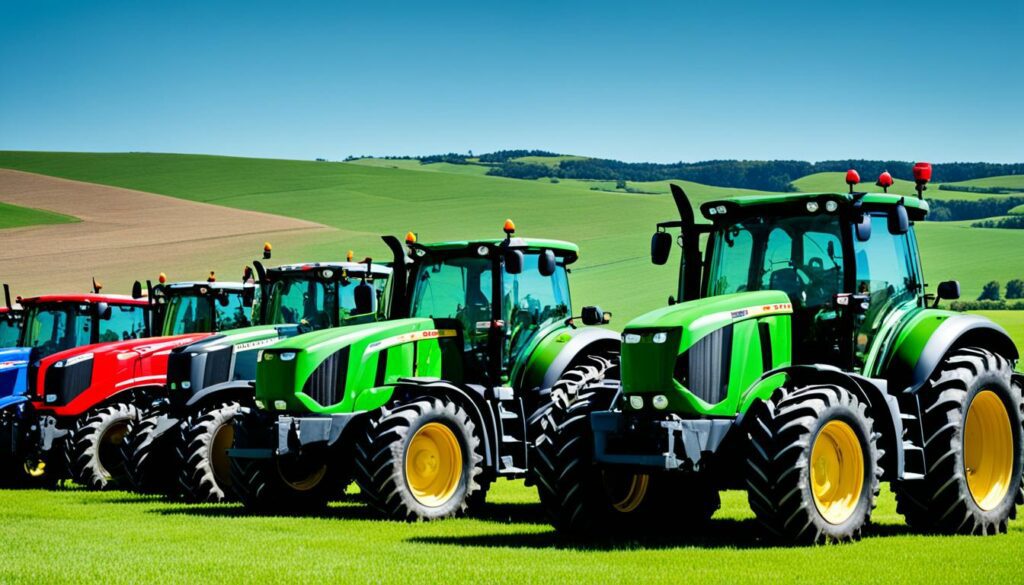
The 2021 WHO Air Quality guidelines show that lowering air pollution can greatly improve health. Though not binding, these rules are based on strong science to limit air pollution effects. Countries base their own air quality laws on these guidelines.
To cut down on farm emissions, we should aim for practices that follow global benchmarks. This means using eco-friendly technology at farms, clean energy in homes, and planning cities to use energy well. Following WHO advice on monitoring and training can help meet these standards.
Global rules also tackle major farm pollution sources like raising animals and using chemicals. By focusing on these areas, we can greatly boost air quality. This is good news for people’s health and the success of farms.
By sticking to global air quality rules, countries can better protect their people. More than half of pollution deaths happen in poorer nations. This highlights how crucial it is to apply these worldwide standards everywhere.
Lowering emissions from farms is key to fighting climate change. It’s crucial for the health of our planet. Sustainable farming practices improve air quality and make farming more environmentally friendly.
Using sustainable methods can cut emissions from farms. Practices like cover crops and minimal tillage keep the soil healthy. They also reduce the need for harmful chemicals. This helps the air and supports a strong farming future.
Integrated pest management (IPM) takes on pests with many different tools. It uses natural and low-chemical approaches to pest control. By doing this, IPM helps keep the air cleaner. It’s a smart way to lower emissions and make the environment safer.
Carbon sequestration is a great way to tackle farm emissions. Farmers can store more carbon by using certain farming methods. This doesn’t just fight climate change. It also boosts the health of the soil, making farming more sustainable.
Back in 2007, US farms were both sources and storers of greenhouse gases. They emitted gases through various activities. By changing how we farm, we can make a difference:
These changes not only fight climate change. They can also bring in money for farmers through ’emission offset’ schemes. By choosing cleaner practices, the farm industry can help the air and the environment.
Some new laws don’t make farmers get greenhouse gas permits. This could encourage them to do more for the environment. Other laws push for more renewable energy from farms, leading to less pollution.
By using sustainable farming, IPM, and carbon sequestration, we can lower farm emissions. This makes our farms stronger against climate change. It’s all about smarter, cleaner ways of farming.
Today, the world focuses on meeting global air quality targets. Many technological advances in farming offer solutions. Precision farming lets farmers use resources better, reducing harmful emissions. It works by using data from sensors and satellites to farm more precisely. This cuts out waste, like too much fertiliser or pesticides, which helps keep the air clean.
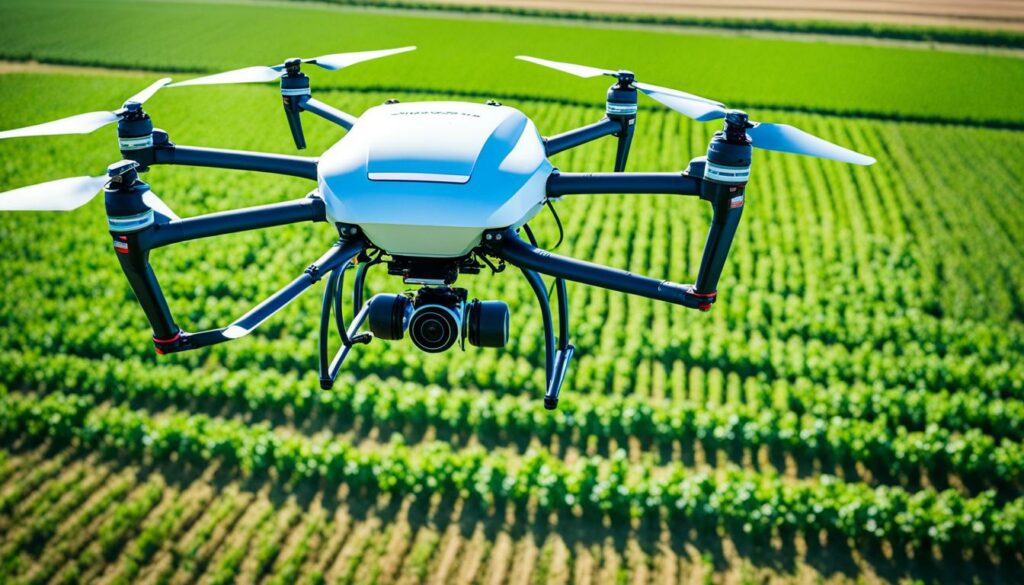
Special machinery is also key to doing farming with less pollution. Things like low-emission tractors and smart watering systems not only make farming more efficient but also meet strict air quality rules. This kind of tech is vital for cutting down on harmful gases and keeping our air and planet safe.
In the U.S., the Department of Agriculture and the National Science Foundation are backing research into smarter farming with about $200 million. This money is used to make tools and systems that help farmers make better choices. These advancements make it easier for farmers to follow air quality guidelines.
| Technological Innovation | Benefit | Impact on Air Quality |
|---|---|---|
| Precision Farming | Optimises resource use | Reduces unnecessary input application |
| Low-Emission Machinery | Increases operational efficiency | Minimises greenhouse gases and other pollutants |
| Advanced Irrigation Systems | Improves water use efficiency | Prevents wastage and reduces emissions |
Using these technologies in farming is extremely important. Laws like the Clean Air Act push for lower pollution levels. They ask communities to have plans if air quality goals are not met. By using advanced and green farming, we can produce food while caring for our planet.
Looking at different countries shows how setting the right air quality rules can help farming and the environment work well together. Take the European Union (EU) for example. It has cut down on ammonia, a major air pollutant, by 23% from 1990 to 2015. These changes came through 27 different country programs, all working together.
Switzerland is also doing its part. It has cut black carbon emissions by a big 70% from 2000 to 2018. This was thanks to strict rules on the particles coming out of diesel engines. Methane, another harmful gas, fell by 16.7% in the same period. Switzerland’s focus on cleaner technology and fewer greenhouse gases made this possible.
Both regions show what happens when strong rules meet smart strategies. In Europe, the latest farming policies are putting a big focus on better air. These plans support efforts to use the land wisely and fight climate change. It gives countries room to deal with their local problems while aiming for bigger environmental goals.
Switzerland’s not just working within its borders. It’s teaming up with others around the world for cleaner air too. Programs with Latin America and China to fight pollution show their global commitment. Aiming for no carbon emissions by 2050, they’re showing their serious about the planet’s future.
| Country | Key Measures | Emissions Reduction |
|---|---|---|
| EU | CAP 2023-27, Regulation Standards, Research & Innovation | 23% reduction in ammonia emissions (1990-2015) |
| Switzerland | Particle Filter Regulations, HFC Restrictions, International Programs | 70% reduction in black carbon emissions (2000-2018), 16.7% reduction in methane emissions (1990-2015) |
These countries’ work in farming and the environment gives others hope. By using good rules, new technology, and teamwork, they are strengthening their farms and protecting the planet. Learning from these stories can help everyone who cares about the future of food and clean air.
Better air quality helps agriculture a lot. Less ozone, dust, and nitrogen dioxide mean more crops and lower costs for farmers.
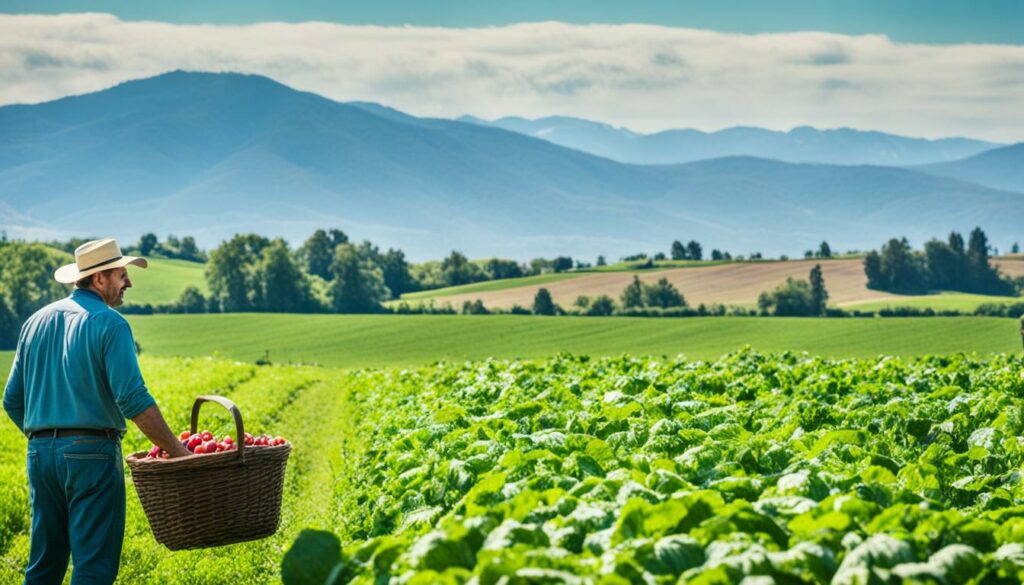
Good air quality means bigger harvests. For example, cleaner air helped raise U.S. corn and soybean yields by 20% from 1999 to 2019. This is worth $5 billion a year. In Europe, ground-level ozone causes a yearly loss of €6.7 billion. Globally, it’s as high as USD 26 billion. Lowering these pollutants saves big.
Clearer air saves farmers money. By using clean farming methods, they avoid health costs from pollution. They also cut down on lost work and early deaths. In areas with lots of pollution, the health benefits of cleaner air can be more than the cost of reducing pollution.
Take India, for instance. Air pollution caused a loss of $95 billion, which is 3% of their GDP in 2019. In China, cutting PM2.5 could save $9.2 billion each year in health costs. Following air quality rules costs less than losing crop profits and facing hard economic times.
| Country | Economic Benefit (USD) | Annual Savings in Crop Yields |
|---|---|---|
| United States | $5 billion | 20% increase in corn and soybean yields |
| India | $95 billion | Equivalent to 3% of GDP |
| China | $9.2 billion | Annual savings in healthcare spending |
Better air quality is clearly good. It means more crops and saves farmers lots of money. These benefits show why managing air quality in agriculture is so key.
Governments and policymakers influence air quality standards, especially in farming. They create clear rules that farming must follow. This ensures our environment stays healthy and so does our health.
Rules for farming are very important. They set limits on things like producing food and using chemicals on crops. Farms must follow these rules to be part of certain agricultural programs. The USDA, for example, makes sure organic food is produced in a way that doesn’t harm the environment.
Governments use money to help farmers choose ‘green’ ways to farm. They pay for good farming methods. And there are ways for farmers to earn money by lowering pollution. This helps to keep our water and air clean. It also supports making wild habitats healthier if farms are in nature-sensitive areas.
Telling people about air quality and farming is important. This helps us understand the health risks of pollution and why it’s good to farm in a clean way. Health specialists work with these campaigns. They explain the dangers of bad air. This teamwork helps make laws that protect our farm and health.
In the coming days, farming’s way of affecting the air we breathe will change a lot. We will see more focus on how we farm in a way that helps the environment. This is super important because farms make a lot of the greenhouse gases hurting our planet.
We now know that the bad air can spoil about a quarter of our main crops in just a few years. So, it’s urgent we switch to ways of farming that are kinder to the air. This not only protects our food but also does good for the earth’s soil and plants.
Using smarter ways to farm can really fix our air problems. Take, for example, using special equipment that plants crops in just the right way. This and other smart farming tricks can lower how dirty the air gets. They can even make the air around farms cleaner and the land healthier.
To stop farms from hurting the air, we need to be careful about how we look after animals and use chemicals. Today, most dirty air comes from animal waste. We can make things better by changing how we do these things. Doing so could make more food without damaging the air, which is good news for millions of people who rely on farming for their living.
| Factor | Impact |
|---|---|
| Ground-level Ozone Pollution | Projected to reduce staple crop yields by 26% by 2030 |
| Greenhouse Gas Emissions | Agriculture responsible for 25% of global emissions |
| Ammonia Emissions from Livestock | Contributes 58% of particulate matter air pollution in European cities |
| Crop Yield Decrease Due to Global Warming | Up to 10% decrease per degree Celsius of warming |
| Benefits of Reducing Nitrous Oxide Emissions | Improved crop yields: 25% for winter crops in China; 10% in Western Europe |
| Economic Benefits of Improved Air Quality | Increased crop yields valued at $5 billion annually in the U.S. |
The future of our air and farming depends on everyone working together. By using new farming methods and cutting back on bad emissions, we can protect our food and nature. This will not just help the planet. It will also keep our farms going for the kids of tomorrow. And it’s a win-win, helping our environment and our economy at the same time.
Agricultural workers face serious health risks from poor air quality. They breathe in a lot of pollutants at work. These include various types of harmful substances.
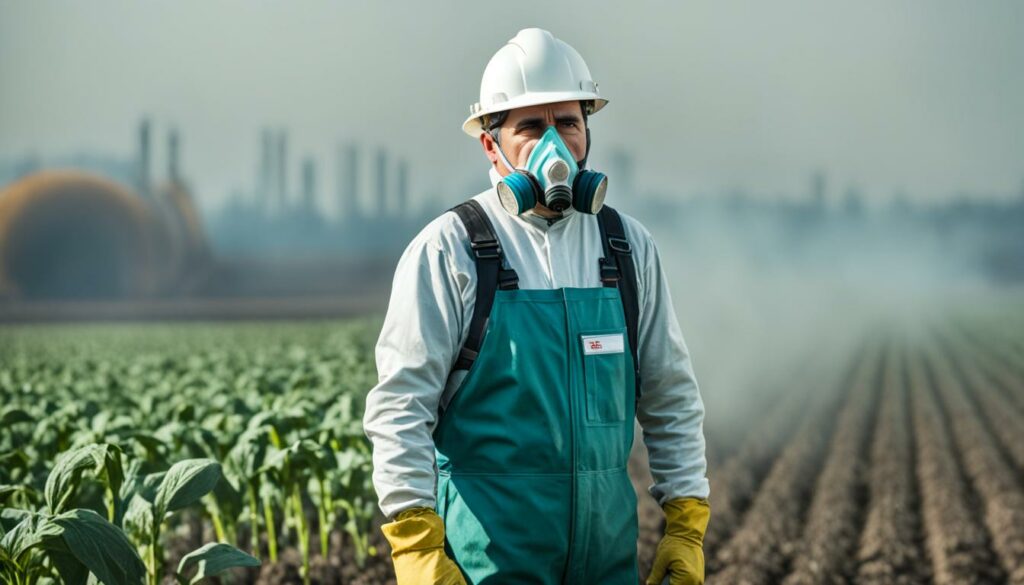
Pollutants in farming settings cover many dangerous substances. They breathe in ammonia, methane, and PM 2.5. They also face risks from VOCs and PAHs. Traffic also pollutes the air with dangerous gases and compounds.
VOCs come from everyday items like paints and pesticides. And burning petrol adds to these hazards. The industries add PAHs to this mix too. All these make the air very unhealthy for agricultural workers.
These pollutants cause immediate harm, especially to workers’ breathing. PM 2.5 is very bad for the lungs. It can make asthma and bronchitis worse. Workers can get very sick from breathing in these particles over time.
Ground-level ozone from traffic makes matters worse. It’s linked to poor lung function and more lung infections. We need to cut these pollutants to protect farmworkers’ lungs.
Bad air can also hurt farmworkers over many years. Breathing in these toxins often leads to serious long-term illnesses. This includes heart and lung diseases, cancer, and early death. Over 6.5 million people worldwide die each year because of air pollution.
Working around these pollutants puts farmworkers at risk of long-term health problems. We must work to reduce these risks for their sake.
Food security links closely with climate change and bad air quality. It greatly affects how sustainable our farming is. Bad air quality can hurt food distribution and make staple crops less efficient.
For example, in the United States, farm goods like crops, animals, and seafood add over $300 billion to the economy every year. But in 2011, heat waves caused more than $1 billion in losses. These losses hurt the people who grow our food.
In the world, U.S. farms contribute nearly 25% of all grains sold. This shows how important they are for global food needs. When we include food services, this sector adds a huge $750 billion to the economy.
Climate change is making agriculture harder with hotter temperatures and extreme weather. This makes feeding our growing global population a bigger challenge.
Poor air quality also affects sea life. Important fish like the American lobster and others have moved north over 100 miles since the 1960s. This can harm local economies that depend on fishing, which brings in more than $1.5 billion each year.
Bad air does not just harm fish. It also reduces the amount of wheat, corn, and soybeans grown. This leads to big losses every year. For the U.S. alone, the loss is around $3.1 billion.
About 40% of crops need insects like bees to produce. Air pollution might be one reason we are seeing fewer bees. This could further decrease food security.
Tackling these environmental issues is crucial. It’s needed to help small farmers and make sure food is available to everyone.
The close tie between global air quality standards and farming is shown by powerful facts and research. Bad air directly lowers crop growth and is a danger to people’s health. For instance, up to 10 million deaths a year are linked to outdoor dust from burning fossil fuels. Also, things like black carbon add to dangerous warmth in the air, highlighting the need for strict rules on air quality.
The need for healthy farming is very important. For example, by 2030, ozone could cut staple crop growth by 26%. This might mean up to $20 billion in losses each year. Plus, bad air doesn’t just affect one area. The WHO says over 90% of the planet has air quality problems.
Looking at how farming and air quality connect, we see the need for many actions. This includes tough rules, better farming tech, and working together globally. By cutting down on harmful things like the 95% of ammonia from farm waste and chemicals, we help fight climate change. This also boosts crop growth and makes sure there’s enough food. Bringing farming in line with air quality rules is key for a future where nature and farms can grow together.
The link between air pollution and agriculture is strong. Farming adds to air pollution. This happens through animal emissions, fertilisers, and pesticides. But, pollution also harms crops, making it hard to grow food.
Ground-level ozone comes from burning fuel and using chemicals. It can lower crop production. By 2030, crops like wheat and rice might see smaller yields. This leads to big economic losses and less food.
Air pollution can cut down crop yields. The result is big financial losses for farmers. By cutting out harmful pollutants, crops could grow more. This would mean more money for farmers.
Global air quality rules aim to cut pollution from farms. They’re there to make sure farming helps the planet. These standards want farming to be cleaner and safer for us all.
Farming adds to air pollution in several ways. This includes animal waste, chemicals from fertilisers, and dust. These can turn into harmful pollutions, making our air dirty.
These rules make sure farming is good for the Earth. They help cut down on harmful gases and pollutants. This makes the air and climate better for everyone.
Climate change is making it harder to grow crops. It’s getting warmer, extreme weather is more common, and some areas can’t grow crops anymore. This affects food for us all and the jobs of many.
We need global air quality rules to improve the planet. These rules guide countries in making farming cleaner. They aim to protect the environment while keeping food coming.
Using cover crops, reducing chemicals, and managing soil better tackles emissions. Carbon sequestration in farming also helps. All these methods make farming less harmful to the Earth.
Smart technology and better machines can cut down on pollution from farming. They make farming more efficient. This helps keep the air clean.
The success stories teach us we can make farming and the environment work together. They show how new policies and everyone working together can protect our planet and its people.
Better air for farming means more food and money. For example, cleaner air in the U.S. could boost crop earnings by billion every year.
Leaders help by making laws that make farming cleaner. They offer support for using greener methods. They also teach people why clean air in farming matters.
Farming needs to be greener to fight climate change. This means using new tech and methods. We must grow food in ways that don’t harm the planet.
Air pollution can make farm jobs harmful to health. It causes breathing problems and serious diseases. Better farming ways are key to keeping workers safe.
Dirty air makes it hard to grow food, affecting many lives. Cleaner farming is vital for our food and jobs. It ensures food reaches everyone safely.